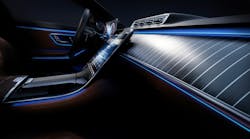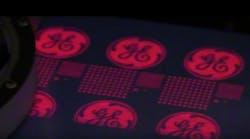Sony demonstrated an 82-inch LCD TV with LED backlighting, which enables wider color gamut. The full HD (resolution 1920 x 1080) screen has 120 Hz motion compensation technology and 10-bit panel to increase the gradation level, effectively eliminating image blurring, for example when watching sports footage.
Sony also introduced a 70-inch flat-panel, high-definition LCD television with the company's Triluminos LED backlighting. The new Bravia KDL-70XBR3 model is the world’s largest TV compliant with xvYCC technology, a new IEC standard, which Sony has branded x.v.Color™.
The 70-inch TV, the largest in Sony's top-end Bravia line, will ship this February for about $33,000. The xvYCC standard expands the current color data range of video by approximately 1.8 times resulting in the television’s ability to display more natural and vivid colors similar to what the human eye can actually see.
As well as its 102-inch plasma and 100-inch LCD displays, LG Electronics exhibited a 47-inch full HD LED-backlit LCD TV with a dynamic contrast ratio of 20,000:1 and 105 % wide color gamut.
JVC demonstrated a 37-inch LED-backlit LCD TV, as well as a rear-projection HD-ILA using LEDs as the light source. Unlike many other RPTVs that use DLP technology, JVC's approach uses LCOS (liquid crystal on silicon) technology. JVC says the set has a startlingly high contrast ratio and the wide color range allows for flexible color management.
JVC has also built a prototype 110-inch rear projection TV using the company’s HD-ILA technology. The full HD set, like currently available HD-ILA televisions, uses three 0.7-inch 1920x1080 pixel full HD D-ILA (LCOS) devices. Power consumption is 230 W.
Sony shows 27-inch OLED TV
Sony demonstrated OLED televisions with two prototype models, a 27-inch TV with Full HD panel (resolution: 1920 x 1080) and an 11-inch TV with wide-SVGA panel (resolution: 1024 x 600).
The TVs are extremely slim, measuring approximately 3 mm depth and 10 mm in depth for the 11- and 27-inch models, respectively, at the thinnest part of the body.
The next generation TV displays provide high contrast, wide color gamut and quick response time. Sony suggests it will soon begin mass production of smaller size OLED TVs, while panels for mid- and large-size TVs are currently under development.
A Yahoo blog has photos of the OLED displays.
DLP rear-projection TV
Texas Instruments showed what it described as the first HDTV with hang-on-the-wall slim design featuring LED illumination and full-HD 1080p resolution. The product is enabled by a new 0.65-inch 1080p DLP chipset that is optimized to drive LED arrays to drastically increase contrast performance beyond 100,000 to 1.
LED illumination increases the color saturation to nearly 140% of the NTSC TV standard and delivers a color refresh rate of up to 48x the standard TV frame rate when combined with the inherent speed of DLP technology. LED illumination also provides "instant On/Off" functionality and replaces a conventional lamp with a long-lasting (lifetime) light source.




